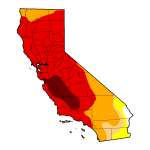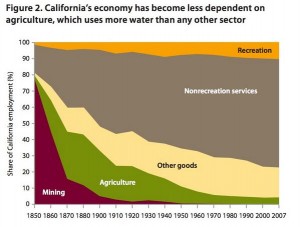California, listen to me. (Grabs home state firmly by the shoulders, stares into California’s face intensely.) You can do this. It’s going to be OK.
I know, I know. “Zero” sounds bad. But you go into a drought with the water supply and water system you have, not the one you might want or wish to have at a later time. You’ve got too many people for a year like this, and too large farms and too few water meters and too little groundwater regulation, and it’d be great if we could go back in time and fix that stuff. But those mistakes have already been made – crazy big ones, frankly, but that’s what you’re stuck with.
The thing to remember – and this’ll help you get through the tough year ahead – is that drought is no one big thing. It’s a series of little things – one water user, one water system at a time. That’s how you’re going to get through this. If you focus on “zero” you’re screwed. Think about who’s actually going to be short of water, and what they’re going to do about it.
Let’s start with Matt Weiser’s excellent piece in yesterday’s Sacramento Bee, in which he wisely put scare quotes around the word “zero” after the California Department of Water Resources announced a zero allocation for the State Water Project. As Matt explains, “zero” doesn’t necessarily mean “zero”. First of all, it’s a starting point, and could rise if it rains and snows. Second, the State Water Project is only one source among a number for most water users. Some of those other sources are stressed, but “zero” doesn’t mean taps going dry:
The “zero” forecast affects urban and agricultural areas from San Jose to San Diego that depend in part on water diverted from the Sacramento-San Joaquin Delta. Most of these areas have other water sources to draw from, including local reservoirs and groundwater wells. (emphasis added)
If you’re a farmer who depends on SWP water, this is a deep bummer. Farmers and the communities around them are going to suffer economically:
The State Water Project serves about 750,000 acres of farmland. Most farmers have access to surface water and groundwater, including private wells, and it’s common for them to be given short allotments in drought years. Before Friday’s announcement, the State Water Project delivery forecast was only 5 percent of the maximum amount allotted in its contracts with water agencies.
Even so, the announcement assures further conservation measures will be required, and may press some farmers to fallow land. (emphasis again added)
If that’s you, this really sucks. But for most of California, that’s not you. From Ellen Hanak and colleagues at the Public Policy Institute of California:
[A]griculture and related manufacturing account for nearly four-fifths of all business and residential water use—but make up just 2 percent of state GDP and 4 percent of all jobs.
But what about the core necessities – water for our sinks and showers and toilets? If you depend on the Shaver Lake Heights Mutual Water Company in Fresno County or 16 other mostly rural water systems around the state identified by the state as facing “severe water shortages in the next 60 to 100 days”, look out. But in a state with 38,332,521 residents, give or take a few, the fact that only 17 relatively small communities have so far been identified as being at risk of running out of water means that the vast majority of the state’s population is currently not at risk of running out of water in the next 60 to 100 days. In a drought this badassed, it so far looks like most of California’s residents will be able to flush their toilets and brush their teeth for the foreseeable future.
OtPR, who is much smarter than I am about such things, thinks I’m being overly optimistic when I make this argument:
Oh no. There are about 4000 water districts in CA (if you count thirty-dwelling mutual water companies in the middle of nowhere). I’d bet a good third of them will be in a bad way this year. We’re just hearing from the earliest and direst ones.
So I’m probably saying something really dumb here. But having watched Texas go through this, and having covered and lived through New Mexico’s tough times last year, I’m going to boldly predict that most water providers will limp through to the finish line. In Texas, the national press repeatedly descended on Spicewood Beach to tell the story of drought because nobody else was actually out of water. People deal with this by using less water. Somewhere in the dangerous future, conservation may lead to demand hardening that will make this a much more difficult problem. But for now, there are a whole lot of you using more than 200 gallons of water per person per day. You’ve got plenty of room to move.
Years ago, the great Kelly Redmond offered this helpful definition of drought – “insufficient water to meet needs.” The key here is that needs can change, and this year, my beloved California, they are going to have to.
You can do this.



I ran to my local Orange County water district’s website to see if we had new rules and regulations, and found a pleasant suprise (although not a complete surprise, as I was aware of the city of Irvine’s sustainability efforts.)
We’re not totally immune from longterm drought — one still needs rain to replenish groundwater, not just rely on treated recycled water — but considering that Irvine has more than doubled in population from about 100,000 to 220,000 during the past 20 years since I moved bere, I’m pretty proud of what it’s done to secure its water supply and cut down its dependence on water from CA aqueducts.
Last on the teat….
If I may, John, what might be useful is to break down exactly what the farmers on the SWP are growing.
Is it cotton and alfalfa or is it stuff we eat directly (we can cut down meat by doing a meatless monday and maybe NoDak can ramp up beef now that Texas doesn’t grow cattle [due to drought….hmmmm]).
Would be interesting, IMHO, to look a little deeper at SWP vs CVP crops (and IID too) and what Salinas Valley is thinking.
Just a thought.
The other key point about the zero allocation is that the State Water Project is husbanding what will water is left in Lake Oroville for later potential emergency use — so people who really need water will get. And, as Dan Bacher is happy to complain, major Northern California reservoirs were drained down substantially over the past year (as if anything else is supposed to happen to reservoirs in a dry year), not least to fill up the Met’s big reservoirs, so the Southern California Megalolopolis is just fine for this year and even next. (That’s why the state can cut off the water supply to 25 million people, at least temporarily.)
In brief, I don’t think there’s going to be any serious problem for any municipal water users, though of course we’ll have to take shorter showers and pee on the lawn as Jerry Brown suggests.
That said, the brilliant Ellen Hanak makes me insane sometimes. Yes, agriculture is just 2 percent of GDP and 4 percent of state jobs. Yes, in the big picture and from the perspective of the Public Policy Institute’s headquarters in San Francisco, the ag cutbacks are temporary and a modest hit to the economy. But we’re not talking about a 2 percent hit to the state’s economy; we’re talking about a 100 percent hit to many communities’ economies. The drought’s extremely disruptive to San Joaquin Valley ag — where the aquifers are already suffering mightily — and that region just happens to be what would, if it were an independent state, be the poorest in the nation. (The Legislative Analyst just did the math, because of a crackpot proposed ballot measure: http://www.lao.ca.gov/ballot/2013/130771.aspx.)
I don’t much care about Stuart Resnick’s problems, but this will be taking a real human toll.
Thanks much for posting this calm advice about understanding the California drought. It rings true from what I know in Florida. Modern water supply systems are amazingly overbuilt and almost always very resilient in drought. The planners, funders, and managers of those systems deserve great credit for creating secure supplies of water. There nonetheless can be some water users harmed by a drought. Your very important point, as I understand it, is that people usually far overstate the magnitude and scope of that harm. It is hard to resist that impulse but we otherwise could make some pretty bad water decisions.
Yes, this is all pretty reasonable. I’m on the board of Santa Clara Valley WD, and we’ve got plenty of stored water, but project a likely decrease into a zone where we need to call for water savings. So far we’re asking for 10% reductions.
As to limping over the finish line, I guess that depends where the line is. If we get an El Nino this year, maybe things won’t be too bad. If we have a repeat of the 87-92 drought, it’ll be bad for a lot of small systems and not easy for the rest of us. If we get a repeat of what the historical record suggests is possible (even ignoring whether climate change makes something even worse possible), then that would be a problem for all of us.
Pingback: Another Week in the Ecological Crisis – February 2, 2014 – A Few Things Ill Considered
Pingback: Are we really ‘running dry?’
Pingback: Blog round-up: Bloggers on the drought, proposed federal water legislation, the BDCP and fracking, and more » MAVEN'S NOTEBOOK | MAVEN'S NOTEBOOK
Pingback: An update on California towns running out of water. Or not. | jfleck at inkstain
Pingback: How well is California weathering the drought? | jfleck at inkstain